Jesús Soto
Presentación de Muret
El pasado día 21 de febrero presentamos Muret en Santomera. Os dejo el reportaje que hicieron en 7 Televisión Región de Murcia.
Novela histórica Muret

Ya está a la venta mi novela MURET.
En ella relato la historia de Adán de Alascún, un joven aragonés cuya vida da un vuelco la noche que se celebra la victoria en la batalla de las Navas de Tolosa. Resignado por el peso de la culpa, descubre que su pasado ha sido un engaño. Un engaño que comenzó unos años atrás, cuando iba a casarse con su amada. Pronto un oscuro secreto se cobijará en su interior, que lo conducirá hacia el único propósito que lo mantiene vivo: la venganza.
La novela nos relata una historia de amor, traición y poder en el devenir del reino de Aragón. A través de sus páginas cabalgaremos parejos a la historia de Aragón en Occitania. Estaremos presentes en momentos decisivos que explican la cruzada cátara; la situación feudal de Occitania en el siglo XIII; la injerencia de los reinos colindantes por el dominio de una tierra rica y la influencia de la Corona de Aragón.
De la mano del joven Alascún viviremos el amor, el odio y la sinrazón que llevaba a los caballeros medievales a morir en las batallas. Adán nos guiará por un entramado de caminos de orgullo, ambición y felonía que confluirá en la villa de Muret. El castillo de Muret será testigo mudo de reyes vasallos, condes más poderosos que sus señores y cruzados que solo se arrodillan ante la cruz. Unas murallas frente a las que todos empeñarán sus destinos a un Juicio de Dios.
Developing an intelligent system for the prediction of soil properties with a portable mid-infrared instrument
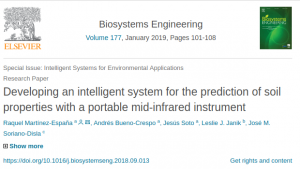 Ya está disponible nuestro nueva publicación.
Ya está disponible nuestro nueva publicación.
Developing an intelligent system for the prediction of soil properties with a portable mid-infrared instrument.
Highlights
- •Different machine learning techniques have been tested to predict soil properties.
- •The predicted soil properties are TC, TN, CEC, clay, silt and Na+.
- •The best predictive machine learning technique has been the Gaussian Process.
- •The Gaussian process is better compared to the traditional PLSR technique.
- •The Gaussian Process is the candidate for the development of intelligent system.
High-Throughput Infrastructure for Advanced ITS Services
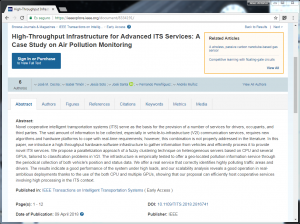 Hoy nos han comunicado la publicación de un nuevo artículo, con el que llevábamos trabajando desde el año pasado.
Hoy nos han comunicado la publicación de un nuevo artículo, con el que llevábamos trabajando desde el año pasado.
High-Throughput Infrastructure for Advanced ITS Services: A Case Study on Air Pollution Monitoring.
Abstract:
Novel cooperative intelligent transportation systems (ITS) serve as the basis for the provision of a number of services for drivers, occupants, and third parties. The vast amount of information to be collected, especially in vehicle-to-infrastructure (V2I) communication services, requires new algorithms and hardware platforms to cope with real-time requirements; however, this combination is not properly addressed in the literature. In this paper, we introduce a high-throughput hardware-software infrastructure to gather information from vehicles and efficiently process it to provide novel ITS services. We propose a parallelization approach of a fuzzy clustering technique on heterogeneous servers based on CPU and several GPUs, tailored to classification problems in V2I. The infrastructure is empirically tested to offer a geo-located pollution information service through the periodical collection of both vehicle’s position and status data. We offer a real service that correctly identifies highly polluting traffic areas and drivers. The results indicate a good performance of the system under high loads, and our scalability analysis reveals a good operation in real-ambitious deployments thanks to the use of the both CPU and multiple GPUs, showing that our proposal can efficiently host cooperative services involving high processing in the ITS context.
A novel fuzzy clustering approach to regionalise watersheds
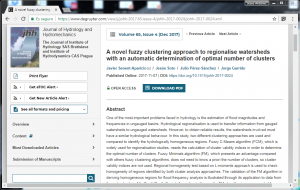 Otra artículo que nos publican: A novel fuzzy clustering approach to regionalise watersheds with an automatic determination of optimal number of clusters. Una nueva aplicación de los algoritmos de clasificación difusa.
Otra artículo que nos publican: A novel fuzzy clustering approach to regionalise watersheds with an automatic determination of optimal number of clusters. Una nueva aplicación de los algoritmos de clasificación difusa.
Abstract
One of the most important problems faced in hydrology is the estimation of flood magnitudes and frequencies in ungauged basins. Hydrological regionalisation is used to transfer information from gauged watersheds to ungauged watersheds. However, to obtain reliable results, the watersheds involved must have a similar hydrological behaviour. In this study, two different clustering approaches are used and compared to identify the hydrologically homogeneous regions. Fuzzy C-Means algorithm (FCM), which is widely used for regionalisation studies, needs the calculation of cluster validity indices in order to determine the optimal number of clusters. Fuzzy Minimals algorithm (FM), which presents an advantage compared with others fuzzy clustering algorithms, does not need to know a priori the number of clusters, so cluster validity indices are not used. Regional homogeneity test based on L-moments approach is used to check homogeneity of regions identified by both cluster analysis approaches. The validation of the FM algorithm in deriving homogeneous regions for flood frequency analysis is illustrated through its application to data from the watersheds in Alto Genil (South Spain). According to the results, FM algorithm is recommended for identifying the hydrologically homogeneous regions for regional frequency analysis.
Influence of multivariate modeling in the prediction of soil carbon by a portable infrared sensor
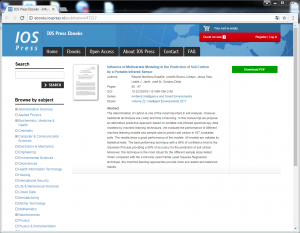 Contribución Workshop Proceedings of the 13th International Conference on Intelligent Environments, Seoul, Korea, August 2017.
Contribución Workshop Proceedings of the 13th International Conference on Intelligent Environments, Seoul, Korea, August 2017.
Abstract
The determination of carbon is one of the most important in soil analysis. However traditional techniques are costly and time consuming. In this manuscript we propose an alternative predictive approach based on portable mid-infrared spectroscopy data modeled by machine learning techniques. We evaluate the performance of different machine learning models and sample size to predict soil carbon in 457 Australian soils. The results show a good performance of the models. All models are validate by statistical tests. The best performing technique with a 99% of confidence level is the Gaussian Process providing a 98% of accuracy for the prediction of soil carbon. Moreover, this technique is the most robust for the different sample sizes tested. When compared with the commonly used Partial Least Squares Regression technique, the machine learning approaches provide more successful and balanced results.
Big Data con MATLAB
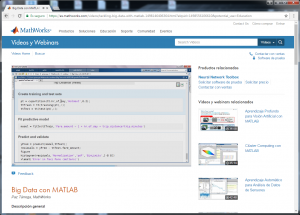 Interesante Webinars de cómo MatLab trata grandes conjuntos de datos
Interesante Webinars de cómo MatLab trata grandes conjuntos de datos
Big Data con MATLAB
Paz Tárrega, MathWorks
Descripción general
Según crecen nuestros datos en tamaño y complejidad, se hace más difícil trabajar con ellos, particularmente cuando los datos no caben en memoria. MATLAB ofrece un entorno único para trabajar con big data conviertiendo el análisis y el proceso de big data en fácil, coveniente y escalable.
En este webinar aprenderá estrategias y técnicas para manejar grandes volúmenes de datos en MATLAB. Se muestran las nuevas capacidades de la versión 2016b de MATLAB, incluyendo tall arrays. Utilizando tall arrays puede prescindir de aprender programación orientada a big data o técnicas de manejo de datos fuera de memoria, simplemente utilice el código y la sintaxis que utiliza hasta ahora de MATLAB.
